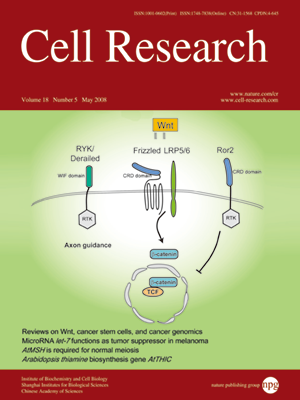
Volume 18, No 5, May 2008
ISSN: 1001-0602
EISSN: 1748-7838 2018
impact factor 17.848*
(Clarivate Analytics, 2019)
Volume 18 Issue 5, May 2008: 589-599
ORIGINAL ARTICLES
The Arabidopsis MutS homolog AtMSH5 is required for normal meiosis
Xiaoduo Lu1,2,*, Xiaolin Liu2,3,*, Lizhe An1, Wei Zhang4, Jian Sun2,3, Huijuan Pei1, Hongyan Meng2,3, Yunliu Fan2,3 and Chunyi Zhang2,3
1School of Life Sciences, Lanzhou University, Lanzhou 730000, China
2Biotechnology Research Institute, Chinese Academy of Agricultural Sciences, Beijing 100081, China
3National Key Facility for Crop Gene Resources and Genetic Improvement (NFCRI), Beijing 100081, China
4School of Life Sciences, Shanghai University, Shanghai 200444, China
Correspondence: Chunyi Zhang(chunyi.zhang@caas.net.cn)
MSH5, a member of the MutS homolog DNA mismatch repair protein family, has been shown to be required for proper homologous chromosome recombination in diverse organisms such as mouse, budding yeast and Caenorhabditis elegans. In this paper, we show that a mutant Arabidopsis plant carrying the putative disrupted AtMSH5 gene exhibits defects during meiotic division, producing a proportion of nonviable pollen grains and abnormal embryo sacs, and thereby leading to a decrease in fertility. AtMSH5 expression is confined to meiotic floral buds, which is consistent with a possible role during meiosis. Cytological analysis of male meiosis revealed the presence of numerous univalents from diplotene to metaphase I, which were associated with a great reduction in chiasma frequencies. The average number of residual chiasmata in the mutant is reduced to 2.54 per meiocyte, which accounts for ~25% of the amount in the wild type. Here, quantitative cytogenetical analysis reveals that the residual chiasmata in Atmsh5 mutants are randomly distributed among meiocytes, suggesting that AtMSH5 has an essential role during interference-sensitive chiasma formation. Taken together, the evidence indicates that AtMSH5 promotes homologous recombination through facilitating chiasma formation during prophase I in Arabidopsis.
Cell Research (2008) 18:589-599. doi: 10.1038/cr.2008.44; published online 1 April 2008
FULL TEXT | PDF
Browse 2002


